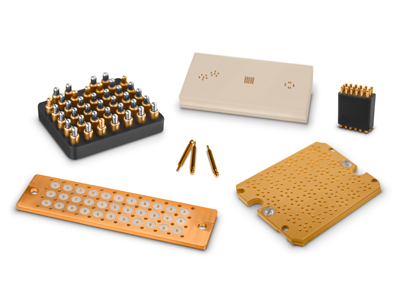When looking at spring probe contact technology the solution you choose must meet the mechanical, electrical and environmental performance requirements required in today’s space market. The lifecycle of spring contact probes is dependent on the design of the probe and as well as the operating conditions in the field. Design and manufacturing challenges take place to meet the rigors of the space market environmental requirements.
The following are 8 key advantages to know about spring probe contact technology in the space industry:
1. Shock and Vibration: When designing for shock and vibration, it is essential to have a good understanding of the application requirements. Standard requirements are 20 G sine and random vibration, and 50 G shock with no micro interruption longer than 1 microsecond. Mission requirements exceed these values often with the use of explosive bolts and latches. This can drive the shock accelerations into the thousands of G’s. Spring probes design variants are proven to survive over 2000 G shock.
2. Thermal cycling: Designing for elevated temperatures, the spring material selection must address stress relaxation. Typical materials for the spring are Beryllium Copper, Music Wire and Stainless Steel. Most common temperature test performed for spring material range from -85°C to 250°C, although some applications may require a wider range of temperatures.
3. Cycle Life: In most space applications, the connector is mated / unmated just a few times (during testing or device assembly) – although movement of the plungers may be dictated during shocks or thermal cycling. Applications requiring active cycling are achievable; with known environmental conditions. Hundreds to thousands of cycles are achievable.
4. Vacuum conditions: This limits the selection of the insulation materials as well as the plating process and poses requirements on general cleanliness of the manufacturing process.
5. Absence of debris / loose particles: Material selection must be selected in order to minimize the risk of having loose particles, ensure that material selection, plating and biasing design is considered in detail. Spring probe assembly operations should be performed in as clean an environment as possible.
6. Contact resistance: Contact resistance requirements may vary significantly with the application. A low and stable contact resistance is ideal, although, for signal applications, may not be strictly mandatory.
7. Current rating: Depending on the application – usually current rating for signaling applications is low (less than 1A), but higher currents may be required in some cases.
8. Signal integrity: Depending on the application for high frequency coaxial interconnects and/or high speed digital differential pair applications, it is paramount that signal integrity must be maintained with frequencies of DC-50 GHz and data rates up to 10 Gbps. The solution must be designed to meet your requirements comprised of a solderless board to board standalone compressible coaxial or differential spring probe configurable to various stacking heights and size constraints while meeting your electrical signal integrity requirements and mechanical packaging constraints.
This will help you achieve your X-Y misalignment tolerance conditioning issues and z-axis size constraints with a greater ease of assembly with vastly reduced costs, complexity and rework while meeting your electrical performance requirements. This offers 4-5 degrees of freedom forgiveness and manufacturing alleviations.

Smiths Interconnect's spring probe contact solutions feature IDI contact technology, are compliant which makes them ideal for blind mate applications as they offer forgiveness or x, y, z, rotational and angular misalignment of the target. Offered in compressed heights less than 2 mm and utilized on pitches as tight as 0.4 mm, they are well suited for high density, board-to-board, battery contact and high frequency space applications.
In summary, spring probe contact technology can provide significant benefits in space and satellite applications over traditional pin and socket connector systems. It is critical to fully understand the application requirements to best balance the design trade-offs to make the best implementation of spring probe contacts and connectors to meet the reliability and efficient design needs of today’s satellite and space craft challenges.
Decades of experience have positioned Smiths Interconnect well – both in designing and delivering state of the art spring probe solutions specifically engineered and designed to support the trends and technology of the future.


